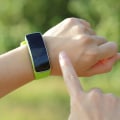Most smartwatches and fitness trackers use high-precision light sensors with PPG (photoplethysmography) technology that use a light source on the back of the watch to measure the amount of red and green light reflected by the skin on the wrist. A heart rate sensor in a smartwatch measures the heartbeat of the person wearing it. It usually works by illuminating the skin and using photodiodes to detect the amount of reflected light. Intelligent algorithms then use changes in light reflection caused by blood flow through the wrist's capillaries to calculate the heart rate.
This information can be used for a variety of purposes, such as monitoring exercise intensity, tracking sleep patterns, and detecting signs of stress. The heart rate sensors in smartwatches are generally less accurate than heart rate monitors for medical use. Even so, they can provide a reasonable estimate of a person's heart rate for everyday use. The oximetry sensor helps measure blood oxygen saturation.
Blood oxygen saturation can determine if the lungs are working properly. The sensor normally projects light through the user's skin and measures the amount of light absorbed by the blood. It then uses this data to determine the level of oxygen saturation. Ambient light sensors are commonly found in smartwatches to automatically adjust screen brightness based on ambient lighting conditions.
These sensors work by detecting the amount of light in the environment and adjusting the screen brightness accordingly. Ambient light sensors can conserve battery life by automatically reducing screen brightness in low light conditions, helping to extend the device's total battery life. This MEMS accelerometer sensor helps track body movements by calculating daily steps. In addition to monitoring sleep patterns, an accelerometer can help recommend techniques to improve sleep quality.
The sensor detects the skin's resistance to a specific current that the portable device transmits to the skin to monitor parameters such as heartbeats and sleep patterns. It is a sensor that calculates body orientation and angular rates. Your device's gyroscope will immediately alert you when you move your wrist to look at your smartwatch. The sensor also helps your portable device save battery power by turning off the screen when no movement has occurred.
A microphone is a device that detects sound and converts it into electrical signals. When you have your phone in your pocket, you can use these sensors to make calls directly from your arm. If you have an active Wi-Fi connection, this feature also allows you to make voice calls. The room temperature sensor in a smartwatch helps measure the temperature of the environment surrounding the watch, not the body temperature of the person wearing it.
This information can provide a general idea of the temperature of the surrounding area, but it is not a reliable or accurate way to measure a person's body temperature. A smartwatch's magnetometer is a type of sensor that measures the direction and strength of a magnetic field. This magnetic field data can be used for a variety of purposes, such as determining the user's orientation and detecting changes in the magnetic field, which can be used for navigation, fitness tracking and other applications. The magnetometer can also be used with other sensors, such as accelerometers and gyroscopes, to provide more accurate and complete data.
An altimeter detects changes in altitude using atmospheric pressure. The total number of flights of stairs you have been climbing will be summarized and calculated as a factor in your calorie count. This makes your calorie production more accurate. The most common and basic tracker included is the accelerometer.
It can be used for multiple things, but it's usually done by counting the steps. By measuring the orientation and the accelerating force, they can determine if the device is horizontal or vertical, and if it is moving or not. The most typical feature of an accelerometer on a smartwatch is motion tracking. Taking the Starmax GTS4 as an example, the Starmax GTS4 accelerometer can measure the user's activity levels when running or jogging.
Based on these measurements, you can count the steps and thus calculate the distance, calories and other data. Since the accelerometer can be used to indicate the orientation of the device in relation to Earth's gravity, it is possible to correctly orient the smartwatch screen by determining the upward direction. The Starmax GTS2 and GTS4 adopt this principle by lifting the user's wrist to activate the smartwatch screen. Gyroscopes and accelerometers are sensors that are used to measure the movement of an object, but they work differently.
Gyroscopes are primarily used to monitor the angle of an object to capture its angular velocity and changes in direction. Some smartwatch manufacturers even combine accelerometers and gyroscopes for triangulation and obtaining a more precise orientation of objects. With the help of various smartwatch sensors, smartwatches can track health and exercise. But do you really know what sensors are hidden inside the Fitbit or Garmin fitness device you wear on your wrist or on your Apple Watch? Keep reading to find out.
.








